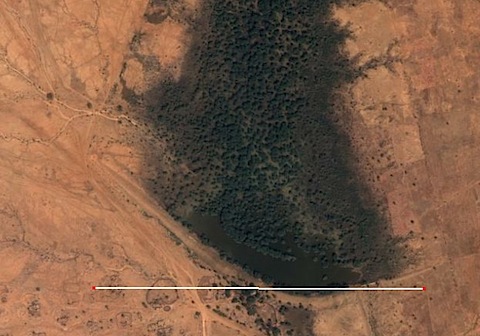Bug Girl has pulled the plug on her blog, which is a crying shame. As a tribute, and to show you why I enjoyed it (even though I didn’t often link to it) here’s a link to the post that first brought Bug Girl to my notice: Cochineal: it’s a bug AND a feature. Enjoy it while you can, and join me in hoping Bug Girl can be tempted back.
Desert botany
As we’ve said before, we like blog carnivals. They expose us to new things, and they expose new people to our things. And that is why, despite the frequent lack of direct agricultural interest, we’re always happy to point you to the carnivals that have been good enough to feature our posts.
Berry Go Round no. 14 is up at Gravity’s Rainbow, where there is a bouquet of posts on topics ranging from Darwin’s tree ferns to baby’s breath ((Another accursed common name; Gypsophila elegans, if you please.)) If you fancy submitting something for next time, when the carnival will be hosted at A Neotropical Savanna, you’ve got till the end of the month.
The second edition of Carnival of the Arid is up too, at Coyote Crossing, which is where it started. Some wonderful photographs at Gossamer Tapestry. Maybe some of those are wild relatives? And maybe one of the desert rats over there in the American southwest can shed some light on the true history of Luigi’s mysterious millennial Anasazi beans.
We’re shameless enough to have sent our Sudanese trees to Festival of the Trees No. 33, which is also up at local ecologist. There’s enough there to satisfy the craziest tree hugger, including a little something on alder cones. I hope Michael Bell, who commented recently on his plan to develop alder as a grain crop, is watching. Again, submitting is easy, and again you’ve got till the end of the month.
Featured: Lactose
Ola, on The lactose reflux problem:
Introgression from Neanderthals as a source of adaptive variation is a fascinating hypothesis; I like the idea that Homo sapiens have benefited from alleles from wild relatives. Recent adaptation and all the signs of positive selection in human population following the shift to agriculture based diets expose the fallacy of proponents of the Paleolithic diet … not to mention all the doctor Atkins disciples out there.
Time for a genome sweep.
Blooming desert

The picture, from Google Earth, shows a bit of Sudan in December 2003. The white line is 1 km long. I think that’s standing water just above the line, with quite large trees north of the water. How they got there made my jaw drop.
John Greenfield ((Please, please let that be his real last name, for the sake of nominative determinism.)) was working on a “Savannah Development Project” almost 40 years ago. The project required a D6 Caterpillar bulldozer to make airstrips for the project’s plane. In between times, John put the bulldozer to other uses:
I constructed a massive absorption bank across a dry Wadi in order to show the Sudanese, the importance of moisture conservation. I remember when I was building this bank thinking, you will be able to see this from the air.
And you surely can! As John points out, one of the big problems with desert soils is that they crust over, so that any rain that does fall runs off and does not penetrate. Slow the flow down, with any kind of barrier on a contour, and the water goes into the soil. John’s idea was for “linear farms” established behind vetiver hedges.
Once you have collected runoff from a wadi, and let it soak in to the soil you can grow some very useful crops that would have been impossible without the moisture conservation. The biggest problem with deserts is uncontrolled runoff – hence my idea of ‘Linear farms’ behind vetiver hedges – a farm 10m wide X 1000m along the hedge equals 1 ha. That is a hectare of land that would produce well, as opposed to the thousands of hectares of little farms producing a few survivors of what was planted.
When I worked in this desert, I use to visit these little farms and talk with the farmers ( who made their money out of collecting Gum Arabic, and were bloody well robbed) We would look at their ‘farm’ and there would be a dozen or so stalks of sorghum waving in the breeze and I would ask why they thought those plants grew well when the rest failed – no idea – on closer inspection of the surviving individuals, they were all, without exception, growing in hollows in the field that the runoff had collected in. Now, I said, if we extended these ‘hollows’ around the contour or across the slope (made contour furrows) then all the seed would flourish. And doing just that enabled me to produce the heaviest crops of Sorghum this area had ever seen.
Did anything ever become of the idea? I doubt it, or we would surely have heard about it. But it seems on the face of it a brilliant technique for using agrobiodiversity to enable farmers to grow more agricultural biodiversity.
And if you want to see for yourself, point GE at 13 05’22.52â€N 30 14’09.07â€E
Up is the new down
Further to Luigi’s trend-setting (and spotting) piece positing that an economic downturn could mean an upturn for agricultural biodiversity, I note from our friend Danny Hunter’s blog that LEISA is asking its local partners a couple of germane questions:
What are the effects of the global economic crisis that you see in your own environment, at the level of target groups (e.g. food prices, changes in agriculture, availability of credit, etc…)?
Does it affect the functioning of your own organisations or networks? How?
Answers are coming in, and LEISA is continuing the discussion on an open forum. Anyone care to fillet the answers for agrobiodiversity-specific information?